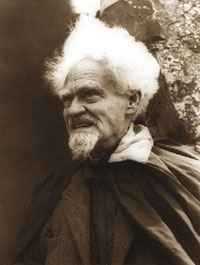Inspired by the Goddess
Carol P. Christ writes about the rebirth of the Goddess, feminism, ecofeminism, feminist theology, societies of peace, and the Goddess Pilgrimage to Crete.
“THE OLD RELIGION” OR A “NEW CREATIVE SYNTHESIS”?
Is Goddess feminism an old religion or a new creative synthesis? Can it be both? Goddess feminism draws on the feminist affirmation of women’s experiences, women’s bodies, and women’s connection to nature; the feminist critique of transcendent male monotheism as the symbolic expression of male domination of women and nature; and 19th and early 20th century discussions of Goddesses and matriarchy.
Most Goddess and other spiritual feminists have experienced Wiccan rituals, which are often simply called Goddess rituals. For many of us, elements of Wiccan practice strike a chord of knowing, while other aspects seem odd or strange or even just plain weird. What are the origins of Wiccan ritual? Are some its roots to be found in male secret societies that in no way promoted "the full humanity of women"?
In their syntheses of women’s experiences, ancient Goddess religions, and feminism, Z Budapest and Starhawk drew upon the earlier creative synthesis of the Englishman Gerald Gardner which he variously called “the Old Religion,” “Witchcraft,” and “Wicca.”
Gerald Gardner (1884-1964) in his books books, Witchcraft Today (1954) and The Meaning of Witchcraft (1959), claimed to have learned “the Craft” from a witch in the New Forest of England who inherited her knowledge from “ancient” traditions passed down in folk practices and rituals kept secret because of the witch persecutions of the early modern era in Europe.
Gardner’s books were known to Budapest and Starhawk. Starhawk was initiated into the “Faery Tradition,” which was influenced by Gardnerian Witchcraft. Both accepted Gardner’s depiction of “the Old Religion” and his reconstruction of “Wicca” at face value, speaking in authoritative tones of “our tradition,” “Wicca,” and “Witchcraft” as having roots in the deep past.
Gardner’s notion of Wiccan High Holy Days set on the Equinoxes, Solstices, and “Cross-Quarter Days” in between has been adopted into feminist Goddess practice without question. In fact, festival days in agricultural religions are tied to the seasons, but not necessarily to specific positions of the sun. Gardner’s designation of the practice of “magic” as the mark of a “witch” was accepted as the defining element of the Old Religion. Many of those influenced by Budapest and Starhawk (or by other followers of Wiccan traditions) are not aware that what is presented as “tradition” is in many respects the creation of Gerald Gardner.
In fact, as deconstructionist historian Ronald Hutton has shown in The Triumph of the Moon, Gardner cobbled together his version of “the Old Religion” from his wide knowledge of the alchemical and magical tradition as passed down in the rituals of secret societies such as the Golden Dawn, the Rosicrucians, and the Masons; his study of folk religion in England and its colonies; his own interests in naturism and nudism; and 19th and 20th century reconstructions of ancient Goddess religion.
Many feminist Wiccans assume that practicing “skyclad” (without clothes) is a necessary part of “the Old Religion,” when in fact the “tradition” of nudism in Wiccan practice derives from Gardner’s reaction against Victorian sexual repression. Neither Victorian nor post-Victorian, priestesses in ancient Crete exposed their breasts but wore elaborate long skirts and aprons that covered their lower bodies and genital areas, while priestesses in ancient Greece wore flowing robes that covered all of their sacred parts.
Feminist Goddess worshippers (myself included at one point) follow Starhawk in calling upon the “Guardians of the Watchtowers” of the East, West, North, and South without recognizing that this ritual phrase derives from the western alchemical tradition and not from ancient Goddess religions. Similarly feminists use athames (ritual knives) to draw pentagrams (5 pointed stars) without knowing that these symbols are more prevalent in magical traditions than in ancient Goddess religions.
Starhawk presents magic, which she defines as “the art of changing consciousness at will”as the meaning and purpose of ritual. Z touts magic in the form of spells as an essential feature of feminist witchcraft. My focus is somewhat different. I would argue that the meaning and purpose of ritual is the community’s acknowledgement of its participation in the cycles of birth, death, and regeneration in all of nature. One could argue that such participation changes consciousness, and this would be true. However, I would argue that the purpose of ritual is to align the community with a power or powers greater than that of any individual. In other words ritual is not about me, not about achieving my will, and not about getting what I want through magic spells.
To recognize that Gardner created Wicca from a variety of sources is not to devalue his achievement. In his book Creative Synthesis and Philosophical Method, philosopher Charles Hartshorne defines the creative process not as creation from nothing, but as “creative synthesis” in which previously existing elements are combined in a new way. Looked at from this perspective, Gerald Gardner’s creation of Wicca was a highly successful new creative synthesis, which spoke to and continues to speak to many.
The fact that Gardner said he discovered rather than created Wicca can be understood as a partial truth. For all of us who have discovered the Goddess and religions that celebrate the human connection to rather than separation from nature, there is a strong element of rediscovery of ancient truth. However, the fact that Gardner spoke authoritatively of all aspects of “Wiccan tradition” as having been inherited from the past can now be understood as false. Whether he deceived himself before he deceived others on this matter may never be known.
Similarly Z Budapest and Starhawk should be understood as having produced new creative syntheses of feminism and Witchcraft that have spoken to hundreds of thousands of women–and in the case of Starhawk to men as well. I do not believe that they understood the degree to which Gardner created–rather than transmitted—Wiccan tradition when they spoke of its roots in the deep past. The truth in their statements has to do not with the details of Wiccan practice, but rather with the deeper truth that there was a time when female power and female wisdom were symbolized by the Goddess. One of the key elements in their new creative syntheses is their insistence that women can be our own spiritual authorities and that we can and must end patriarchy.


Now that we know that Wicca was Gardner’s creative synthesis and not a simple inheritance from the past, we are free to pick and choose which elements of his synthesis we wish to affirm and which we wish to reject as we continue the process of co-creating a new creative synthesis which is a Goddess religion for our time that affirms the full equality of women and the human connection to the powers of birth, death, and regeneration in all of nature. My suggestion would be to pay less attention to magic and more to the earth and all our relatives in the web of life.
In raising these questions I intend no disrespect to Starhawk or Z--their work has inspired the Goddess movement--nor even to old Gerald. My intention is to raise questions about what we mean when we speak in authoritative tones about the connection of present-day Wiccan, Goddess or Neo-pagan practices to "tradition," "the past," "the Old Religion," and so forth.
I believe we need to take responsibility for our own roles in co-creating spiritualities and to question everything said to be "inherited" from "tradition" in relation to our own experience, thinking, and ethical vision.
I personally do not believe in secret rites and would never affirm the sacrifice of a male God. Though I have had powerful experiences in rituals that followed Wiccan conventions, I have experienced perfectly good rituals in which no athame was used, no circle was drawn, no corners or directions were called down, and no cone of power was raised through non-verbal chanting.
Published in different form on Feminism and Religion.
Carol P. Christ has just returned from the spring Goddess Pilgrimage to Crete which she leads through Ariadne Institute. Space available on the fall tour. Carol can be heard in a recent interviews on Goddess Alive Radio and Voices of Women. Carol is a founding voice in feminism and religion and Goddess spirituality. Her books include She Who Changes and Rebirth of the Goddess and the widely-used anthologies Womanspirit Rising and Weaving the Visions. Follow Carol on GoddessCrete on Twitter.
Comments
-
 Friday, 04 July 2014
Friday, 04 July 2014I like this, Carol. Now I know why the books on Wicca struck such a familiar chord with me, since I am both a former Rosicrucian and a former Masonic Lodge officer! I think that Creative Synthesis is the means by which human beings develop and grow in ALL areas (standing on the shoulders of giants, as the saying goes) - that there is no shame in that, and we should always feel free to retain the elements that still work for us and eliminate those which have outlived their relevance to our times and our needs. I'm a classicist, yet I know full well that Shakespeare, himself, borrowed story lines and characters from many writers who had preceded him. It is the new treatment of old themes that creates a fresh work of art.
-
Please login first in order for you to submit comments


















I tend to believe it is something created a new though on ideas that may go back farther. As mentioned we have more of Ceremonial magic than Witch magic per say. As it works, including the magical parts I see no problem with the fact of its age.
I myself am a innititated Alexandrain Tradtion priest.